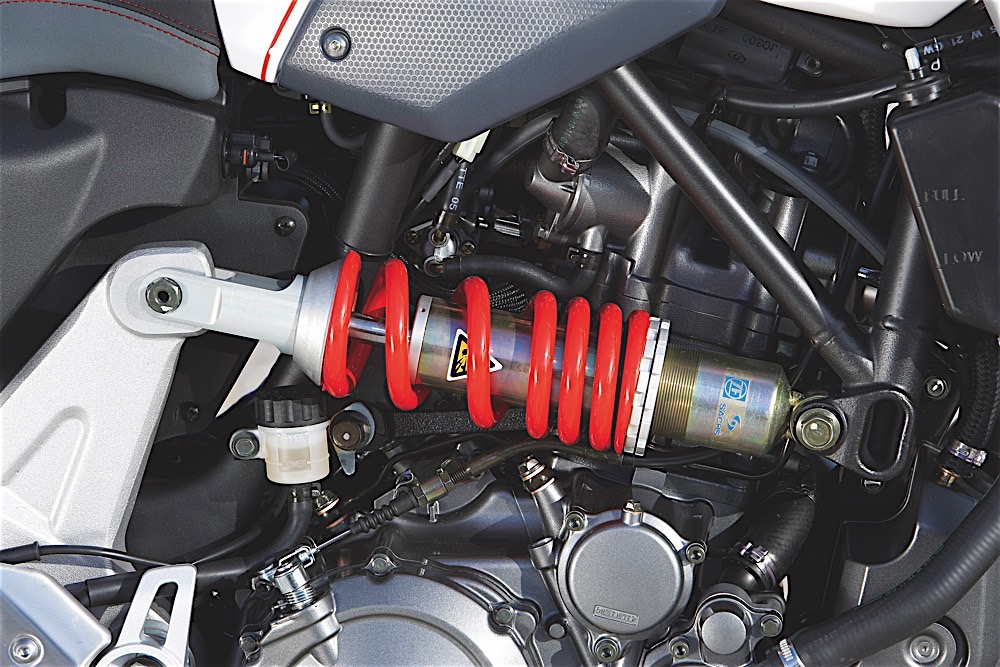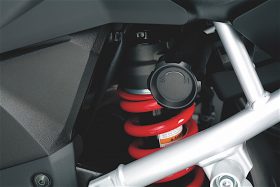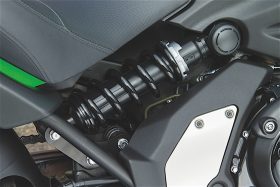Shocking information about suspension and ride height.
Since we’ve recently covered different types of forks and how their damping systems work, it’s time to look at springs. Springs, whether in a fork or on a shock absorber, work exactly the same way and the same rules apply.
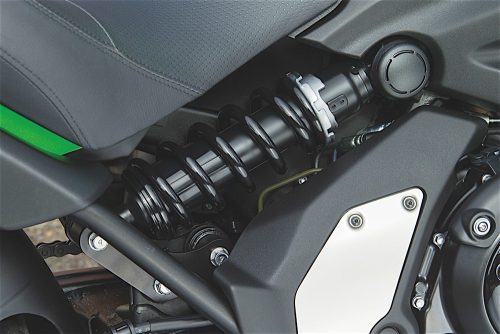 There are two terms we need to first understand and separate: spring rate and spring preload. “Spring rate” is the stiffness of the spring, usually measured in kg/mm. If it takes 10 kg to compress a spring 10 mm, its spring rate is 1.0 kg/mm. A straight-rate spring will maintain this rate throughout its travel, so it would take 20 kg to compress it 20 mm, 30 kg to compress it 30 mm, and so on. Although the pressure to compress the spring increases as the spring is compressed, the rate remains the same, at 1.0 kg/mm.
There are two terms we need to first understand and separate: spring rate and spring preload. “Spring rate” is the stiffness of the spring, usually measured in kg/mm. If it takes 10 kg to compress a spring 10 mm, its spring rate is 1.0 kg/mm. A straight-rate spring will maintain this rate throughout its travel, so it would take 20 kg to compress it 20 mm, 30 kg to compress it 30 mm, and so on. Although the pressure to compress the spring increases as the spring is compressed, the rate remains the same, at 1.0 kg/mm.
Most springs are straight rate, though there are progressively wound springs that increase in rate as they are compressed. These are easily identifiable by their unevenly wound coils, being closer together at one end (softer rate) and wider apart at the other (stiffer rate).
“Preload” is the amount a spring is compressed when assembled on a shock or fork, in its relaxed, or fully extended, position. All springs are assembled with some preload, meaning they are slightly compressed even when the damper is fully extended. For one thing, this keeps the spring from rattling around. It also puts the right amount of force on the suspension for proper operation throughout its travel. Many motorcycles have adjustable preload, which adds more compression to the spring while in the relaxed position.
One common misconception is that increasing the preload will make the suspension stiffer. While this may be true on a progressively wound spring, most bikes use straight-rate springs. Compressing these further only raises the ride height; it does not increase the spring rate, which is what determines the spring’s stiffness.
There are a few reasons to adjust the ride height. Proper ride height places the motorcycle in the correct attitude to maintain its handling characteristics regardless of the load. Adding a passenger and luggage, for example, compresses the rear end of the bike more than the front. This alters the fork angle, kicking it out more, which also increases trail, which slows steering. Cornering clearance is also reduced, and if the shocks are compressed too much, they will operate too far into their stroke and bottom out frequently. Increasing the preload under load places everything where it should be.
In contrast, if the preload had been altered to handle a heavy load, and you then drop off your passenger and empty your saddlebags, the shock now operates near the top of its stroke and will “top out” when extending, meaning it will hammer at the top of its stroke. It’s important to note that suspension works in both directions, compressing over bumps and extending over dips. If it tops out, you’ll hear a clunk, and the rear wheel will likely leave the ground, which isn’t really desirable if you’re cranked over in a turn.
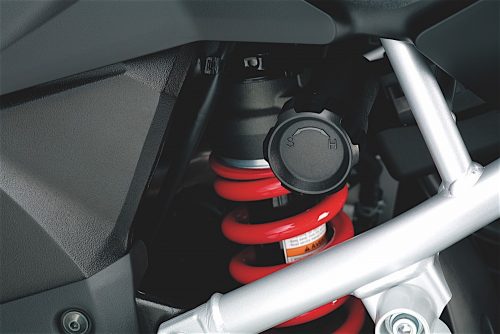 Generally speaking, a motorcycle’s suspension system, front or rear, was designed to work at about a third into its travel. If you can set the preload on your bike so it sits at that level with you on it, you’re good to go. This is called “setting the suspension sag.” To do this, you must first take a measurement with the bike unladen, between a spot somewhere on the rear fender directly above the rear axle and the rear axle. Then, sit on the bike and have a helper take another measurement to see how much the suspension compressed. This distance will vary depending on the bike, but if you know the total rear suspension travel of your bike, usually found on the specs page of your owner’s manual, you can easily determine the sag rate.
Generally speaking, a motorcycle’s suspension system, front or rear, was designed to work at about a third into its travel. If you can set the preload on your bike so it sits at that level with you on it, you’re good to go. This is called “setting the suspension sag.” To do this, you must first take a measurement with the bike unladen, between a spot somewhere on the rear fender directly above the rear axle and the rear axle. Then, sit on the bike and have a helper take another measurement to see how much the suspension compressed. This distance will vary depending on the bike, but if you know the total rear suspension travel of your bike, usually found on the specs page of your owner’s manual, you can easily determine the sag rate.
If you cannot set the sag rate to where it needs to be even at the maximum preload adjustment, or you can only achieve it near maximum preload with only you on the bike, it may be time to look into aftermarket shocks or stiffer springs. My butt proved too lardy for my KLR650, so I installed a stiffer spring. The KLR is a popular bike with tons of available aftermarket parts, so it was easy to find a spring. You might not be so lucky and might have to buy new shocks, many of which are available with different rate springs.
Everything mentioned above also works for the front suspension, though most forks do not provide external preload adjusters. If you determine the sag on your fork is excessive, you can alter it by adding spacers between the fork caps and the springs, though it will be a trial-and-error process. PVC tubing works great for this.
With the preload properly adjusted, you’ll be getting the most out of your bike regardless of the load you carry.
Technical articles are written purely as reference only and your motorcycle may require different procedures. You should be mechanically inclined to carry out your own maintenance and we recommend you contact your mechanic prior to performing any type of work on your bike.









